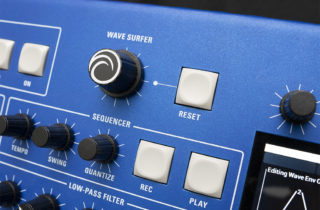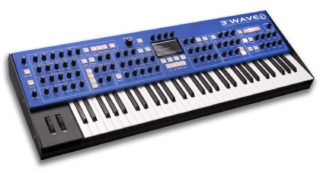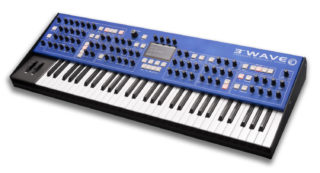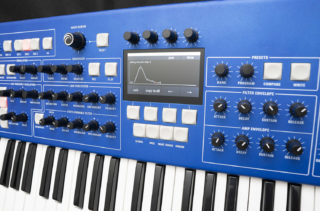Groove Synthesis, an electronic musical instrument startup founded by music industry veterans from Avid/Digidesign and Sequential, has officially introduced its first synthesizer, the 3rd Wave Advanced Wavetable Synth, at the 2022 NAMM Show, being held June 3-5 in Anaheim, California.
The 3rd Wave is a 24-voice, 4-part multi-timbral wavetable synth, with 3 oscillators per voice, analog low-pass filters, a state-variable filter, 6-stage wave envelopes per oscillator, and an industry-first Wavemaker tool that allows users to create custom wavetables in a single step, through proprietary sample-to-wave technology.
Each of its three oscillators can generate a classic PPG-era wavetable, a modern high-resolution wavetable, or an analog-modeled waveform.
While the 3rd Wave has roots in the classic digital wavetable synths of the past, it takes the concept into the 21st century with a lush, expansive sound that’s a product of its expanded wavetables and analog filters. It features a Dave Rossum-designed 2140 analog low-pass filter with variable saturation and resonance compensation, and a second, SEM-style state-variable filter (low-pass, high-pass, notch, and band-pass) for additional tone-sculpting. Both can be used in series for harmonically complex textures.
In addition to its factory wavetables (32 classic PPG-lineage waves plus 48 high-resolution custom waves), users can create custom wavetables of their own using the built-in Wavemaker tool and fill any of the 64 available high-resolution slots. The Wavemaker tool’s sample-to-wavetable capability allows users to connect an audio source to the synthesizer’s rear-panel audio input and generate a 64-wave wavetable at the touch of a button. Alternatively, users can import a 96kHZ wav file into the synth using USB.
With 24-voices, the 3rd Wave can handle note-intensive performances, layer up to 4 parts or create 4 independent split zones — each with a completely different sound, sequence, and dual effect. Each part has independent panning, volume, effects, and a dedicated stereo physical output.
Each of its 3 wavetable oscillators per part/voice has its own 6-stage, loopable wave envelope, which can create complex, evolving soundscapes.
Its pattern-based sequencer can sequence notes, songs, and parameters. Because the synth is multi-timbral, each of its 4 parts/layers has its own sequencer track. Sequences can be up to 24 patterns of up to 32 measures in length. Users can perform in real-time on the keyboard while a sequence or song plays. Users can also perform looped overdubbing of notes or parameter changes to build complex patterns interactively.
Other features include two digital effects per part, four ADSR envelopes (filter, amp, and two auxiliary) per part, four LFOs per part, and a 28-slot mod matrix per part. The synth is housed in a robust, all-metal chassis with a premium 5-octave, semi-weighted Fatar keyboard.
Pricing and Availability
The 3rd Wave is slated for release in August of 2022, with an introductory price of $3795 USD. See the Groove Synthesis site for details.







Sounds pretty good to me, given the constraints of YouTube audio. The specs are a little ambiguous, though. For example, are there really two analog filters per voice (24 analog filters)? Even if there are, the price is a little steep, putting it in contention with the arguably 4th generation Waldorf Iridium keyboard, and not too much less than a Waldorf Quantum. If it were available in a desktop module that maintained all of the synth characteristics of the keyboard, I could, potentially, be convinced to replace my Iridium Desktop with one. That’s a pretty big “if”, though.
I would love if Groove Synthesis could organize to produce a VST version of this instrument. Or hey Waldorf…. I would be happy to pay for a Largo/PPG Wave update with wavetable import….
$3800 is a bit of a financial hit, but hey, the specs are incredible. A state-variable filter is always a good thing. I hope it will do well enough to have a smaller model appear. The sound is demigodly. That PPG thing is part of the synthesizer lexicon. This is the right way to make it a more serious player again.
No $#@! refrigerator-sized CPU cabinet, either!
I would take an 8-voice, monotimbral version of this for less $$$
Happy to see it’s a super synth and not another boring budget oriented one, I hope it will be successful enough that they will consider a desktop version
A high pricetag doesn’t make an instrument better than other instruments per se.
What i have noticed so far is that pricetags are determined by the quality or availability of parts or the popularity of the product. Larger companies can probably buy parts in larger amounts with discount. Also they can take more risk while they are selling more than 1 product.
On the other hand some companies put a high pricetag on their product because they want to make customers believe that it is realy special/exclusive.
This company is new and has to proof itselfs despite their knowledge and experience.
Saying your happy about the high pricetag is just an inconsiderate comment.
Why does Groove Synthesis have to “prove” anything? The proof is in the finished product on display: It is tangible and available for all to evaluate with their ears and hands. I, for one, am surprised it does not cost more given that there are 24 analog filters and 24 state-variable filters. The component cost alone must be significant.
Thank you for sharing from your extensive experience in manufacturing synthesizers, this all sounds like very nice assumptions based on true knowledge about the inside of the business.
But I was talking about the feature list and the promised build quality that seems to indicate they are not aiming to compromise much or to cut corners to much just to make it more accessible.
Can’t wait to tweak that wave surfer knob. But yeah, a desktop version would be very welcome:) Provided of course they manage to fit all that controls somehow without going too much into deep menu diving.